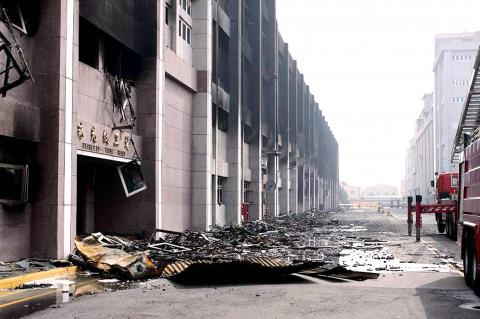Formosa Plastics Group (FPG) chairman William Wong (王文淵) yesterday apologized for a fire at a plant run by group affiliate Nan Ya Plastics Corp (南亞塑膠) in Chiayi County on Sunday.
The head of the nation’s largest private-sector enterprise addressed the apology to all Chiayi residents during a meeting at the office of Chiayi County Commissioner Chang Hwa-kuan (張花冠).
Nan Ya Plastics has launched overall safety checks and will take full responsibility, Wong said.

Photo: Tsai Tsung-hsun, Taipei Times
He told reporters that pending the results of an investigation, he had no idea what caused the fire.
The blaze broke out at about 8:30am on Sunday at Nan Ya’s -Chiayi Second Plant in Taibao City (太保). The factory produced a high-quality waterproof synthetic paper known as white pearl, or PEPA.
It took firefighters nearly 17 hours to extinguish the blaze. No casualties were reported.
The fire dealt another blow to the group after two fires in July at the group’s petrochemical complex in Mailiao Township (麥寮), Yunlin County.
The Chiayi County Government yesterday put together a panel of experts to evaluate damage caused by the latest fire and handle residents’ complaints.
At a news conference before meeting Wong, Chang said the fire was a “serious industrial safety incident” that caused severe air pollution in the county, which is one of the major agricultural areas in the nation.
Anyone who suffered a loss because of the pollution would have an opportunity to present evidence and if a loss could be proven, the panel would help people claim compensation from Nan Ya, Chang said.
Experts were also asked to determine whether the fire affected the quality of water, air or soil in the county, she said.
The Environmental Protection Administration (EPA) said it had collected samples of black-colored rain believed to have been caused by the fire, adding that the report of its analysis was scheduled to come out within a week.
Hsieh Yein-rui (謝燕儒), director of the EPA’s Air Quality Protection and Noise Control Department, said it suspected the rain was polluted by carbon residue caused by incomplete combustion. Aside from determining the cause of the black-colored rain by analyzing the chromaticity and particulates in the polluted rain, Hsieh said technicians at the agency would also look for heavy metals.
Hsieh said Nanya was fined NT$1 million (US$31,950), as the fire produced an unbearable stench in nearby areas.
“The standard value of odor stated as prescribed by law is 50, but the odor detected on location was 229, four times the standard value,” Hsieh said. “Because of the stench, Nanya was fined NT$1 million.”
Hsieh said Chiayi County’s Environmental Protection Bureau monitored air quality near the Nanya plant and found that it contained particulates of 85 micrograms per cubic meter of air after the fire erupted, which was higher than that detected on -regular days.
However, the amount did not exceed the standard value stated in regulations, he said.
The bureau also monitored the air quality in Singang (新港), Chiayi City and Puzih (朴子) on Sunday morning, finding that the density of sulfur dioxide and nitric oxide in Singang surged from four parts per billion (ppb) to 16ppb. Hsieh said the phenomenon lasted about an hour and the density of the two substances had both now dropped to regular levels.
Hsieh said the bureau would continue monitoring air quality in Chiayi, adding that Nanya may be punished further if it is determined that the company did not follow the terms stated in the pollution source operating permit.
In the wake of the incident, the Ministry of Economic Affairs said it has drawn up a cooperation plan with other agencies, including the EPA, to monitor the operations of the nation’s petrochemical industry.
The plan will be implemented immediately if approved by the Executive Yuan, the officials said, adding that FPG petrochemical factories would likely be the first target because of public concern.

Taiwan is gearing up to celebrate the New Year at events across the country, headlined by the annual countdown and Taipei 101 fireworks display at midnight. Many of the events are to be livesteamed online. See below for lineups and links: Taipei Taipei’s New Year’s Party 2026 is to begin at 7pm and run until 1am, with the theme “Sailing to the Future.” South Korean girl group KARA is headlining the concert at Taipei City Hall Plaza, with additional performances by Amber An (安心亞), Nick Chou (周湯豪), hip-hop trio Nine One One (玖壹壹), Bii (畢書盡), girl group Genblue (幻藍小熊) and more. The festivities are to

Auckland rang in 2026 with a downtown fireworks display launched from New Zealand’s tallest structure, Sky Tower, making it the first major city to greet the new year at a celebration dampened by rain, while crowds in Taipei braved the elements to watch Taipei 101’s display. South Pacific countries are the first to bid farewell to 2025. Clocks struck midnight in Auckland, with a population of 1.7 million, 18 hours before the famous ball was to drop in New York’s Times Square. The five-minute display involved 3,500 fireworks launched from the 240m Sky Tower. Smaller community events were canceled across New Zealand’s

‘IRRESPONSIBLE’: Beijing’s constant disruption of the ‘status quo’ in the Taiwan Strait has damaged peace, stability and security in the Indo-Pacific region, MOFA said The Presidential Office yesterday condemned China’s launch of another military drill around Taiwan, saying such actions are a “unilateral provocation” that destabilizes regional peace and stability. China should immediately stop the irresponsible and provocative actions, Presidential Office spokeswoman Karen Kuo (郭雅慧) said, after the Chinese People’s Liberation Army (PLA) yesterday announced the start of a new round of joint exercises around Taiwan by the army, navy and air force, which it said were approaching “from different directions.” Code-named “Justice Mission 2025,” the exercises would be conducted in the Taiwan Strait and in areas north, southwest, southeast and east of Taiwan

UNDER WAY: The contract for advanced sensor systems would be fulfilled in Florida, and is expected to be completed by June 2031, the Pentagon said Lockheed Martin has been given a contract involving foreign military sales to Taiwan to meet what Washington calls “an urgent operational need” of Taiwan’s air force, the Pentagon said on Wednesday. The contract has a ceiling value of US$328.5 million, with US$157.3 million in foreign military sales funds obligated at the time of award, the Pentagon said in a statement. “This contract provides for the procurement and delivery of 55 Infrared Search and Track Legion Enhanced Sensor Pods, processors, pod containers and processor containers required to meet the urgent operational need of the Taiwan air force,” it said. The contract’s work would be